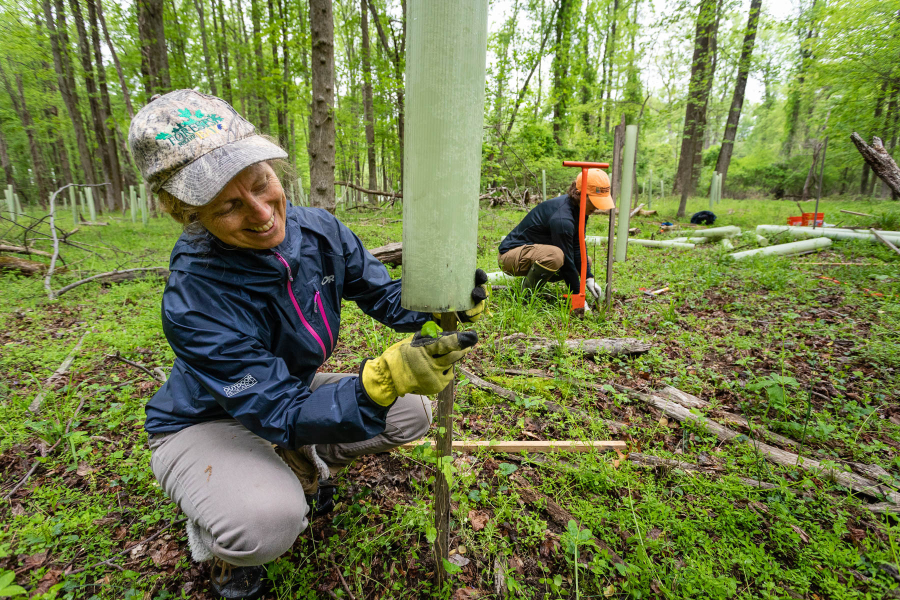How the USDA Forest Service changed the way we think about trees in the Chesapeake
Three Forest Service leaders helped shape the agency’s role in the Chesapeake Bay Program

When the USDA Forest Service joined the Chesapeake Bay Program as a partner in 1990, there was a much different attitude toward forests than there is today. At the time, there was a false perception that the controlled forest harvesting was a significant source of pollution for the Chesapeake Bay. As a result, environmentalists tended to look at forestry through the lens of how it harmed the estuary.
This began to change as the Forest Service became more involved in the work to protect the Chesapeake Bay. After joining the Chesapeake Bay Program partnership, the Forest Service began leading its Forestry Workgroup, which brings together forestry professionals and decision makers from across the watershed. The first liaison between the Forest Service and Bay Program, Al Todd, helped paint a different picture of how forest harvesting affects water quality.
When sustainably managed, forests are allowed to regrow after harvesting and “best management practices” are used to minimize any short-term water quality impacts. Being able to sell timber products helps forest landowners keep their forests as forests, rather than needing to develop their land to make money. Todd helped clarify the narrative around forest harvesting, and also demonstrated that only a very small amount of forested land in the Bay was being managed for harvesting. Compared to the impact of other pollution sources like agriculture or development, forest harvesting was insignificant.
“The Forest Service was able to shift the focus of looking at forests as part of the problem to being part of the solution,” Todd said.

During Todd’s career within the Chesapeake Bay Program, which lasted from 1992 to 2008, he helped to affirm the Forest Service’s role in Bay restoration. In addition to protecting water quality in the headwaters of the watershed by managing National Forests, the Forest Service began playing a bigger role in working with partners to plant new trees and restore forests that were threatened by invasive plants, pests and disease. Federal initiatives such as the Conservation Reserve Enhancement Program (CREP) also started paying farmers to plant riparian forest buffers, which are critical for filtering contaminants from water before it enters streams and rivers.
In 2008, Todd handed the baton to Sally Claggett, who became the new liaison for the Chesapeake Bay Program and coordinator of the Forestry Workgroup. By then, the importance of forests to water quality in the Bay was well known. The State of the Chesapeake Forests, published in 2006, was a “big turning point” for the partnership, according to Claggett, that inspired federal leaders to have a greater focus on conserving and restoring forests.
During Claggett’s time with the Bay Program, the Forest Service began using sophisticated data products to determine the extent of deforestation in the watershed and where states and jurisdictions should focus their efforts. In 2016, the partnership launched high resolution imagery of the watershed’s land cover from 2013 and 2014. In 2022, an updated high resolution imagery dataset from 2017 and 2018 was released, allowing federal, state and local leaders to see first-hand the exactly how much tree coverage they had gained and lost over a four-year period. The Forestry Workgroup recently released a series of fact sheets for each county in the Chesapeake Bay watershed, which can help local leaders plan for forest conservation and tree plantings.

Claggett retired in 2022, and today, Katie Brownson serves as the Forest Service liaison and Forestry Workgroup coordinator. Brownson has the task of implementing the latest Chesapeake Forest Restoration Strategy, which she helped update in 2020. This strategy demonstrates another shift in forestry—one that considers the value of forests for resiliency to climate change and environmental justice, in addition to benefiting water quality and wildlife. Today, the Chesapeake Bay Program uses forest conservation and tree plantings to mitigate flooding, reduce rising water temperatures, combat urban heat islands in cities and provide neighborhoods with adequate tree cover, among other benefits.
“After decades of Forest Service engagement with the Bay Program, there is increasing recognition that forest conservation and restoration is foundational for meeting many of the partnership’s goals, beyond water quality alone,” Brownson said.

Comments
What a wonderful idea! I especially like the way you explain how controlled forest harvesting is good stewardship. Keeping the streams cool helps in so many ways. Will Parsons: thank you for your great photography.
Thank you!
Your comment has been received. Before it can be published, the comment will be reviewed by our team to ensure it adheres with our rules of engagement.
Back to recent stories